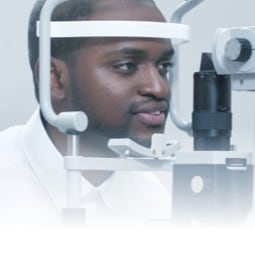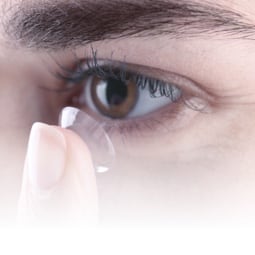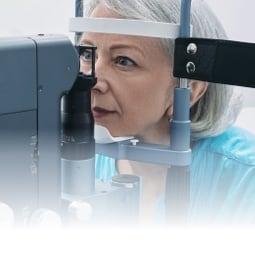Eye Guide for Patients
Getting to know your eyes can help you manage your vision and uncover eye health risks. Learn about eye anatomy basics, common eye conditions, and refractive errors with our educational resources for patients.
Talk to your optometrist to learn more about your unique eyes and vision.
Common Eye Conditions
Thorough eye exams are essential for preventative health care. Regular checkups with your optometrist can help prevent common eye conditions and, when necessary, begin appropriate treatment as soon as possible.
Amblyopia (Lazy Eye)
Amblyopia, commonly known as lazy eye, is a lack or loss of visual development in one or both eyes. The condition usually develops before age 6 and can cause a significant difference in refraction—myopia (nearsightedness) or hyperopia (farsightedness)—between the 2 eyes.
Ambylopia will not go away without treatment and cannot be fully corrected with standard prescription lenses. Vision therapy can train the eyes to work together and improve vision.
Cataracts
A cataract is a cloudy or opaque area that develops in the eye’s lens. Most cataracts develop due to natural aging, occurring in adults over 55. The cloudy area can reduce vision quality and increase light sensitivity. Typically, cataracts develop in both eyes.
Depending on the size and density of the cataract, your optometrist may prescribe eyeglasses or contact lenses to improve vision. When vision is severely affected, cataract surgery may be recommended.
Conjunctivitis (Pink Eye)
Conjunctivitis or pink eye is an inflammation of the conjunctiva (thin, transparent tissue covering the white of the eye and inside the eyelids).
The cause can be allergic, chemical, or infectious. Allergic and chemical conjunctivitis are not contagious; however, infectious conjunctivitis can be caused by bacteria, viruses, and fungi.
Treatment depends on the type of conjunctivitis but usually involves eye drops to reduce inflammation or treat infection.
Diabetic Retinopathy
Diabetic retinopathy is a diabetic eye disease that causes progressive damage to the retina (light-sensitive tissue at the back of the eye). With diabetic eye disease, high blood sugar levels damage blood vessels and cause abnormal growth. Over time, damaged blood vessels in the retina lead to vision problems, including:
- Blurry vision
- Central vision loss
- Floaters & spots
- Poor night vision
With diabetic eye exams, your eye care team can monitor eye health to prevent vision problems and implement treatment when necessary.
Dry Eye
Dry eye or dry eye disease is a chronic eye condition resulting from insufficient tears. When tear produced decreases or tears evaporate too quickly, it can affect eye health and vision. Common symptoms include eye irritation, blurry vision, light sensitivity, and watery eyes.
Contact the Santa Cruz Optometric Center for dry eye therapy to protect your vision and find relief.
Glaucoma
Glaucoma is a group of conditions that result in optic nerve damage. The progressive deterioration of the optic nerve often develops slowly, beginning with few symptoms and potentially leading to blindness. In the early stages, it can cause peripheral (side) vision loss.
The most common cause of glaucoma is increased eye pressure, usually related to fluid buildup. However, glaucoma can also develop in people with normal eye pressure. Comprehensive eye exams and glaucoma screening are crucial to preventing vision loss.
Macular Degeneration
Macular degeneration or age-related macular degeneration (AMD) is the leading cause of severe vision loss in adults over 50. Symptoms include:
- Central vision loss
- Distorted lines & shapes
- Poor color vision
There are 2 forms of AMD: dry and wet.
Dry AMD is slow-developing, resulting from a thinning macula. Currently, there is no cure, but progression can be slowed with dietary changes and nutritional supplements (AREDS 2).
Wet AMD is rapid-developing and causes advanced symptoms. It occurs when abnormal or damaged blood vessels leak in the eye. When detected early, wet AMD can be treated with anti-VEGF injections or photodynamic therapy (PDT).
Eye Anatomy
Vision is a process involving multiple eye structures and neural pathways. When light reaches the eye, it moves through the cornea, pupil, and lens, with each working together to focus light on the retina. Next, the retina gathers light to transform it into visual information. Then, the optic nerve transmits visual information as electrical signals to the brain.
Cornea – the clear front window of the eye helps focus light into the eye. Refractive errors can occur because of abnormal cornea curvature, resulting in poor near or distance vision. Laser eye surgery, including LASIK, alters cornea shape to improve how light is focused.
Ciliary Body – located behind the iris, the ciliary body muscle controls lens movement. The ciliary body also produces aqueous humor, a fluid that nourishes eye tissue and can lead to glaucoma when drainage problems occur.
Iris – the colored part of the eye helps control how much light enters the eye. The iris opens the pupil in low light to let more light inside. In bright light, the iris closes the pupil to let in less.
Lens – also known as the crystalline lens, the lens focuses light by expanding or contracting. The lens is naturally transparent but can become cloudy or opaque due to aging. Cataract surgery replaces the natural lens with an artificial or intraocular lens (IOL) to restore clear vision.
Macula – the oval-shaped center area of the retina containing light-sensitive cells that allow color and detail vision. Macular degeneration is a common age-related condition that affects macula health, resulting in poor or distorted vision.
Optic Nerve – a bundle of over a million nerve fibers that carry visual signals from the retina to the brain. Optic nerve deterioration due to glaucoma can result in reduced vision or blindness.
Pupil – the dark or black opening in the middle of the iris. Pupil size changes to adjust to how much light is available and how much is needed for visual tasks.
Retina – nerve tissue (including the macula) that lines the back of the eye. The retina collects visual information using light-sensitive cells called photoreceptors.
Sclera – the white of the eye and outer layer supporting eyeball structure. It is continuous with the cornea and is covered by the conjunctiva.
Vitreous Humor – the gel-like substance filling the central cavity inside the eye (behind the lens and in front of the retina). The substance is stagnant but can change due to aging, developing clumps of cells known as floaters. The clumps, strings, or spots are typically not harmful, but increased floaters can indicate a retina problem.
Refractive Errors
Refractive errors are a common vision problem affecting more than 150 million Americans. Refractive errors occur when eyeball shape or eye structure condition prevent lights from focusing correctly on the retina. Mild refractive errors may cause few symptoms, while moderate to severe refractive errors can make it difficult to see clearly and affect eye health.
Prescription eyeglasses or contact lenses correct how light enters the eye to improve vision. Laser eye surgery alters cornea shape to reduce refractive errors, including astigmatism, hyperopia, and myopia.
Astigmatism
Astigmatism is a common vision condition occurring when the eye’s surface (cornea) is irregularly shaped. Astigmatism frequently occurs with hyperopia and myopia, resulting in poor close or distance vision. People can have low amounts of astigmatism or severe astigmatism.
Fitting standard contact lenses can be challenging for people with astigmatism. Eyeglasses, rigid gas permeable (RGP) contact lenses, or specialty contact lenses are often a better fit. Your optometrist can work with you to find a solution that compliments your lifestyle and vision needs.
Hyperopia (Farsightedness)
Hyperopia or farsightedness causes blurry close vision. When the cornea has too little curvature or the eye is shorter than normal, light is incorrectly aimed behind the retina instead of directly on it.
When needed, your optometrist can prescribe glasses or contact lenses to improve visual clarity.
Myopia (Nearsightedness)
Myopia or nearsightedness is a vision condition causing blurry distance vision. It occurs when the eyeball shape is too long or the cornea is too steeply curved, causing light to incorrectly focus in front of the retina.
People with high or progressive myopia are at a greater risk of developing eye problems, including cataracts, glaucoma, and myopic macular degeneration. Children’s eye exams are crucial in detecting myopia, as treating myopia at an early age gives children their best chance at healthy lifelong vision.
Presbyopia
Presbyopia occurs when the shape of the eye’s lens changes, affecting the lens’ focusing ability. The change causes problems with near vision, usually due to aging. Reading glasses or contact lenses can help make vision more comfortable.
Come See What We’re About

Visit us
Visit our team at Santa Cruz Optometric Center at our downtown location!
- 904 Cedar St
- Santa Cruz, CA 95060
Hours of Operation
- Monday: 9:00 AM – 5:00 PM
- Tuesday: 9:00 AM – 5:00 PM
- Wednesday: 9:00 AM – 5:00 PM
- Thursday: 9:00 AM – 5:00 PM
- Friday: 9:00 AM – 5:00 PM
- Saturday: Closed
- Sunday: Closed


Our Brands



Our Google Reviews
Be the First to Know,
Be the First to Win.
From eye health insights to exclusive giveaways, your feed just got a lot clearer.








